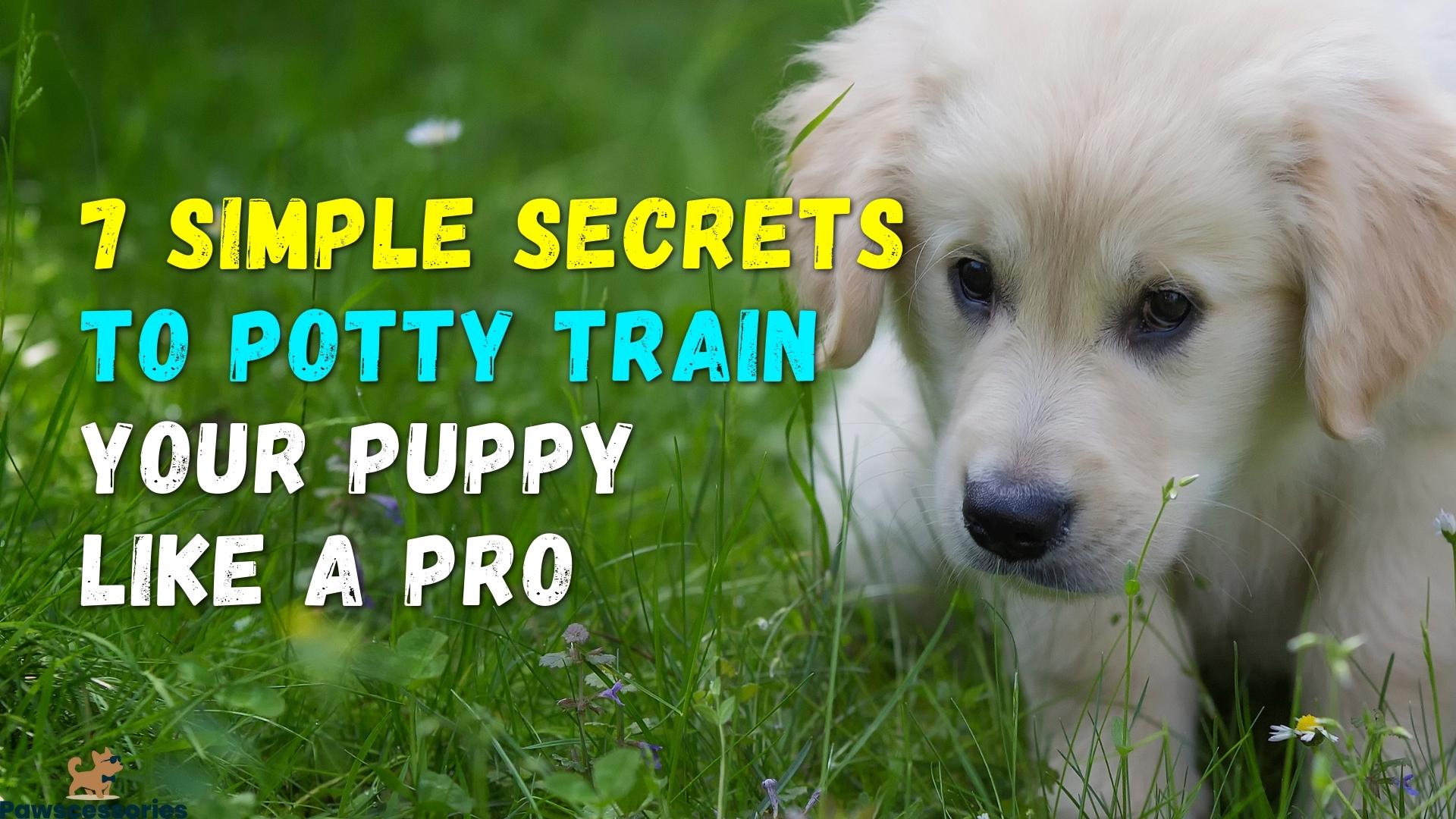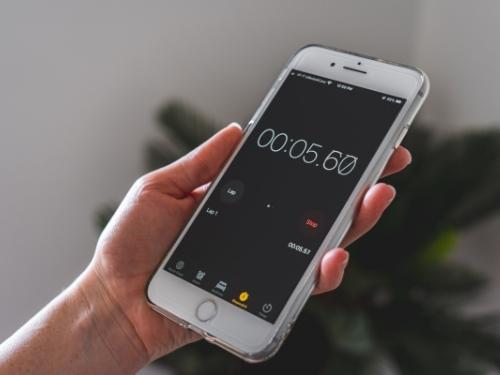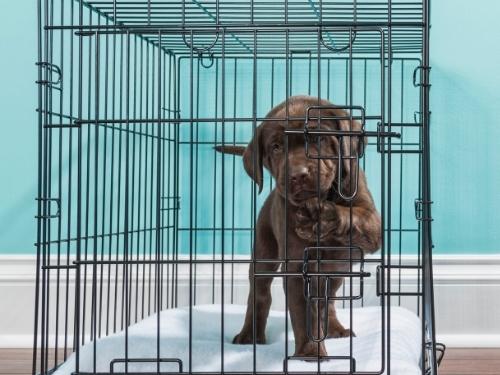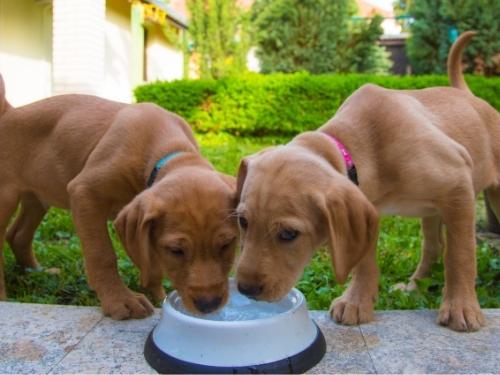Pawscessories is reader-supported. When you buy via links on our site, we may earn an affiliate commission at no cost to you.
Learn more.
Potty training puppies… one of the most frustrating parts of getting a new dog.
We all wish it was a quick process that could be trained overnight but unfortunately that’s just not how it works.
While there are some cases of dogs being potty trained in 7 days not all dogs can follow the same systems and get the same results.
However, there are a few tips and tricks you can use to speed up the potty training process and make your life a heck of a lot easier.
In this article we reveal:
- 7 secrets to potty train your puppy fast (#6 works surprisingly well)
- How to avoid making mistakes that completely kills any progress you’ve made
- The ideal schedule and routine for potty training puppies (We also give away a free potty training checklist)
- How to get your puppy to do their business on command
Table of Contents

How Long Does It Usually Take To Potty Train A Puppy?
How long it takes to potty train a puppy varies from dog to dog, but it typically takes around 4-6 months. However, some puppies can be potty trained in less then a week.
My dog Enzo has a total of 3 potty accidents in the house and is now 1 year and 4 months old. Some puppies just catch on quickly while others take much longer.
Generally, large dog breeds tend to learn potty training faster then small breeds. This is because they have stronger bladder muscles and can hold it for longer periods of time.
If you feel like you have tried everything to potty train your puppy consider one of these online puppy training programs to help.
What Is The Fastest Way To Potty Train A Puppy?
The key to speeding up potty training is watching them like a hawk and using crate training to your advantage.
The first thing you need to do is get a schedule together. Set specific times for meals, playtime, walks and naps. This will help your puppy know when it’s time to go potty.
Next, invest in a good quality crate that’s the right size for your puppy. They should be able to stand up and turn around in their crate, but it shouldn’t be too large. Crate training is great because it gives your puppy a safe place to go when they need to relieve themselves. It also helps them learn to hold it for longer periods of time.
Whenever you can’t watch your puppy, put them in their crate. This will help prevent accidents in the house. With a consistent schedule and proper crate training, you can potty train your puppy quickly and efficiently.
Here is a step by step guide to potty train your puppy fast!
How To Potty Train Your Puppy Fast (7 Potty Training Steps)
Overview of the 7 puppy potty training tips:
- Get The Proper Tools
- Know Your Puppies Potty Timing
- Learn Your Pups Signals
- Set Your Routine & Schedule
- Use Positive Reinforcement Training
- Use Effective Cleaning Products
- Monitor Water Intake
- Bonus: Make Sure They Empty Their Bladder
1) Get The Proper Tools
In order to have success with potty training the first thing anyone needs to do is get the proper tools!
This immediately sets yourself up for success.
Here’s what you’ll need to house train your pup:
- Crate
- Collar
- Leash
- Timer
- Chart
- Treats
- Effective cleaning products
2) Know Your Puppies Potty Timing

How often a puppy needs to go to the bathroom varies.
Age, size, and breed can play a role in the frequency of bathroom breaks they’ll need.
There’s a simple rule dog trainers recommend using called the “month plus one rule”.
Simply take the age of your puppy in months and add 1.
Once done the answer will be equal to how often (in hours) you need to take your pup out for potty breaks.
Here’s the simple equation:
Puppy Age (months) + 1 = Frequency Of Potty Breaks (hours)
For example, let’s say your puppy is 3 months old.
All you need to do is take their age, add 1 and you get 4 hours.
This means you should be taking your puppy out for a bathroom break every 4 hours.
Here’s the problem, this equation isn’t always reliable.
There are too many other variables to consider such as their size, how much they drank or ate, when they last ate or drank, etc.
Most puppies are actually able to hold their bladder and bowel movements while they sleep but when they’re awake its a different story.
Some may need to be let out every 30 minutes or more frequently while awake.
Tip: Grab yourself a timer and track exactly how frequent your pup is going potty. When you’ve determined an average length of time between potty breaks you’ll know exactly when they’re needing out.
Puppies are more likely to need out at specific times throughout the day.
You can make it easier on yourself to house train them by taking them out during these times.
The times these more than likely will need to do their business are:
- After waking up
- After eating or drinking
- After playing
- As often as needed while puppy is active
- As often as needed during the night (you may need to set alarms every couple hours to take them out)
3) Learn Your Pups Signals

No matter how much effort you put into potty training your pup, if you don’t recognize signs of your puppy needing to be let out, no training will work.
Potty training a stubborn puppy can be difficult. Knowing their signals can give you the edge you need to succeed.
Young puppies have no awareness or control of their bladder/bowel movements.
This means early on they may not give signs at all, which is why learning their timing is so important at first.
Over time your puppy will start developing more awareness of their bodily functions.
When they do become more aware they’ll start showing signals when they need to go.
so how can you tell your puppy has to go to the bathroom at this point?
To determine your puppy has to go potty you need pay close attention to their body language. This will give you an understanding of when they need to relieve themselves.
Here are some key signals your puppy has to go to the bathroom:
- They’re playing then suddenly walk away
- They starts sniffing around (looking like they’re searching for a spot to go)
- Your puppy moves towards an area they’ve peed before
- They become distracted, overly excited, agitated, etc. (unique, strange behaviors you don’t normally see are a good indication)
- They start whining
- They’re not interested in treats or toys
4) Puppy Potty Training Routine & Schedule
For any successful potty training strategy a schedule and routine is the ultimate key to success.
Dogs thrive with consistency so make sure to set up a routine and stick to it.
A good idea is to create a simple chart so you can record when your puppy pees and poops.
This will help you keep track and better understand your dog’s potty behaviors. So what is a good potty training schedule for a puppy?
Here is an example puppy potty training schedule:
7:00am – Take them outside. Did your puppy pee and poop?
9:00am – Breakfast.
9:10am – Take them outside. Did your puppy pee and poop?
11:00am – 1:00pm – Naptime.
1:00pm – Lunch time.
1:10pm – Take them outside. Did your puppy pee and poop?
3:00pm – Take them outside. Did your puppy pee and poop?
5:00pm – 7:00pm – Naptime.
7:00pm – Dinner time.
7:10pm – Take them outside. Did your puppy pee and poop?
9:00pm – Take them outside. Did your puppy pee and poop?
11:00pm – Take them outside. Did your puppy pee and poop?
11:00pm – 3:00am – Naptime.
3:00am – Take them outside. Did your puppy pee and poop?
3:00am – 7:00am – Naptime.
Back to the start of the schedule.
There’s a couple things to mention with this schedule.
When you’re waking up in the middle of the night, and they’re not doing their business for at least 2 nights in a row, you can start to stretch out these hours.
On the flip side, if your puppy is having accidents, record it, and adjust the times accordingly.
No schedule is completely set in stone, your puppy is growing and developing so things may change and should be adjusted as often as needed.
Here is a potty training schedule chart you can use to develop your system and track their potties.
5) Use Positive Reinforcement Training
There’s always been a debate in regards to properly training dogs.
Not too long ago (and still sometimes today) people would push their puppies’ noses in their own poop or whack their bum with a rolled-up newspaper.
This is counterproductive when training.
In fact, studies show that when you compare negative vs positive reinforcement, positive reinforcement wins by a landslide.
Puppies learn better and faster when you reward their good behaviors and praise them.
When potty training, always keep treats by the door so every time you need to take them out you can grab some.
In the early stages of training anytime they go potty outside, throw a mini party for your pup and reward them with love, treats, and praise.
Now, what happens when they pee inside?
Your puppy will make mistakes, expect it to happen.
Whenever you catch your pup going number 1 or 2 inside, quickly take them outside.
This should startle your pup when you pick them up and move them outside.
This will help let them know they have done something wrong.
DO NOT punish them.
Puppies have no idea why you’re punishing them and this can result in bad behaviors developing over time.
Bonus Tip – How To Train Your Dog To Potty On Command
This process is quite simple, it looks like this.
When you take your puppy out to go, the moment you notice them squatting to pee or poop (BEFORE they go) you say, “go potty” (or whatever command you’d like).
Then immediately after they go, say “good boy/girl”, and hand them a treat.
By being consistent with this your pup will learn to associate the command you’ve chosen with going to the bathroom.
6) Use Effective Cleaning Products
A classic mistake many dog owners make is cleaning up urine with water.
This leaves behind your dog’s urine scent.
If they can smell it, they’re more likely to urinate in the same spot or nearby.
It’s the same reason dogs pee in the same areas on walks.
Make sure to use a scent spray when cleaning up your pup’s pee.
They’ll help eliminate the smell and prevent your puppy from peeing there again.
Here are some of the best ones you can get on Amazon:
- Resolve Urine Destroyer Spray Stain & Odor Remover
- Resolve Ultra Pet Stain & Odor Remover Spray
- Simple Solution Extreme Pet Stain and Odor Remover
7) Monitor Your Puppies Water Intake

Watch your puppy’s water intake! The more they drink the more they’re going to need to pee.
Some puppies will drink water and immediately need to go out.
Others will drink water and 10-15 minutes later they need to pee.
When you monitor their water intake you’ll begin to know their patterns.
A question many new dog owners ask is, “should we limit how much water they get to reduce accidents?”
The answer is, if your pup is having accidents, taking their water away isn’t going to solve the issue.
They simply need more training.
Water should be available to your pup at all times throughout the day.
The only exception is before bed.
You can take their water bowl away 1-2 hours before bed and that way nighttime accidents are less frequent.
Just don’t forget to give them their water again in the morning!
Bonus Secret: Make Sure They Empty Their Bladder
If you’re further along in your training or have past experience with potty training this might sound familiar.
You take your pup outside, watch them pee, and right when you bring them back inside, they pee again right in front of you…
What the heck is that all about?
Sometimes puppies get overly excited, whether it be from waking up, playing, or simply from going outside.
Whatever the reason is, it can lead to them not fully emptying the tank.
Many pups pee multiple times when given the chance.
So to avoid this, do your best not to distract them mid-pee.
Wait until they’re completely finished and about to walk away before giving them a treat and praising them.
After, stay outside a little longer and let them sniff around. If it looks like they’ve completely emptied their bladder, head on inside.
Now, there are always exceptions and rare situations where a puppy may be peeing more than they should be.
An example would be if they had a urinary tract infection or another medical condition. If you think your pup might be peeing more than normal it’s best to take them to see a vet.
Nothing brings peace of mind quite like speaking with a vet, you can click here to chat with a vet online right now.
How Do I Punish My Puppy For Peeing In The House?
If you catch your puppy in the act of peeing or pooping in the house, say “no” firmly and then immediately pick them up and take them outside to his designated potty area.
If he eliminates there, praise him enthusiastically. If you find their accident after they have already finished you should not punish them as they will not understand why you are angry. Just clean it up with a scent removing cleaner and move on.
They key here is catching them in the act and associating that behavior with something that is unacceptable.
Tips For Potty Training A Stubborn Puppy
How you housebreak a stubborn puppy is by being very consistent with your rules, schedule and supervision. Dogs are creatures of habit, so the more consistent you can make things, the better.
Set a schedule for feeding times, playtimes and walking times, and stick to it as closely as possible. By nature, dogs want to please their pack leader (that’s you!), so if you are consistent with your commands and expectations, they will catch on quickly.
When it’s time to go potty, take your puppy outside to the same spot each time. Use a cue word or phrase like “go potty” so they know what you expect of them. If they do their business, be sure to praise them enthusiastically.
That’s how to potty train stubborn puppies.
Should I Leave Water Out For My Puppy All Day?
One of the most common puppy questions is, “Should I leave water out for my puppy all day?”
Generally, yes, you want your puppy to have access to water most of the day. However, when it’s getting closer to bedtime its fine to remove their access to water.
This can help prevent any accidents during the night. Just make sure in the morning you give them plenty of water to drink so they’re not dehydrated.
A good rule of thumb for potty training a puppy is to remove water 1-2 hours before bed. Then make sure to take them out to pee right before you head to bed.
In the morning and for the rest of the day they should have access to water.
Other Frequently Asked Questions About Potty Training
Can An 8 Week Old Puppy Be Potty Trained?
Yes! 8 week old puppies can be potty trained but it will take some patience and consistency on your part. The key is to create a schedule and stick to it as closely as possible.
Take your puppy outside frequently, especially after they eat or drink. Use a cue word or phrase like “go potty” so they know what you expect of them. If they do their business, be sure to praise them enthusiastically.
With time and patience, your 8 week old puppy will learn where and when to relieve themselves.
At What Age Is It Optimal To Do House Training?
The optimal age to start house training your puppy is as soon as you get them! You want to start building habits immediately. If you start too late, they may have already developed bad habits that will be harder to break.
How Often Do I Have To Go Outside With My Puppy?
It is important to take your puppy outside frequently, especially after they drink, eat or sleep. A good rule of thumb is to take them out every hour or two. If they have an accident in the house, immediately take them outside so that they associate going to the bathroom with being outdoors.
A good rule of thumbs is to take their age in months, and add one to get how frequent in hours they need potty breaks. So, a 3-month old puppy would need to go out every 4 hours.
Now, this is just a general rule, some puppies may need to go out more frequently, while others may be able to hold it for longer periods of time. Pay attention to your individual puppy and their bathroom habits.
Larger dogs can hold their bladders longer then smaller dogs, so keep this in mind.
How Often Do I Have To Take My Puppy Out At Night?
Puppies generally need to go out about every 3-6 hours during the day, depending on their age. At night, they can usually hold it longer. However, this will depend on the individual puppy and their size. It also depends how much water they’ve had before bed.
Again, pay attention to your puppy and their bathroom habits. If they are having accidents at night, then you need to take them out more frequently.
How Do I Potty Train My New Dog When They Are Older?
Older dogs can be more difficult to potty train. This is because they have already developed bad habits and may be resistant to change. However, it is still possible to do it.
If you get an older dog you also want to know their history. Did they potty on a pad inside before? Did they have regular potty breaks? The more you know about their previous habits, the easier it will be to train them.
Older dogs can learn, it just may take a little longer and require more patience.
Here are some tips:
- Take them out frequently, just like you would a puppy.
- Reward them with treats or praise when they go outside.
- Try using a doggy door so they can go outside whenever they need to.
- Be consistent with your commands and praise.
- Do not punish them if they have an accident, this will only make them resistant to learning.
Final Thoughts
Potty training your puppy can be a challenge, but it’s important to be patient and consistent. With time and patience, your puppy will learn where and when to relieve themselves.
Creating and sticking to a schedule is key. Make sure to take them out frequently, especially after they drink, eat or sleep. Use a cue word or phrase to let them know what you expect of them, and be sure to praise them enthusiastically when they do their business.
For older dogs, it may take a little longer to train them, but it is still possible. The key is to be consistent with your commands and praise, and avoid punishing them if they have an accident.
Goodluck potty training your puppy or older dog!
